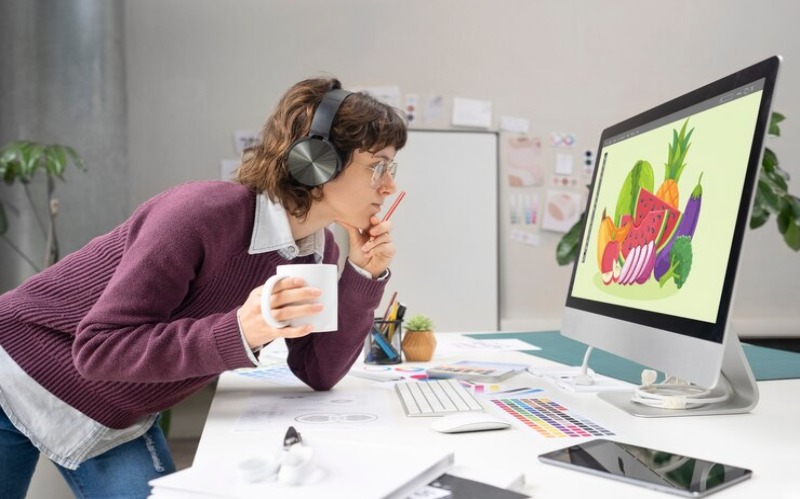
Yes, that’s an AI-generated image. This image that follows isn’t:

This isn’t. Can you tell the difference? AI-generated stock photographs don’t have a good rep—and we can see why. We understand the concept of AI and its benefits; there’s no disputing that. What we’re disputing is how the negatives of AI-generated images are disrupting the creative industry. Well, how they’re disrupting all industries. Read on to find out more.
There is No Creativity in AI-generated Stock Photography
The sad truth is that stock photos created by AI don’t have one of the most essential aspects of an artwork or any other work, and that’s creativity. It’s as simple as that. As much as you might talk to ChatGPT with your pleases and thank yous, it’s simply an AI chatbot with no one on the other side.
It’s not the same as if you get royalty free photos for commercial use by Depositphotos – someone has put the effort into designing them with their creative mind.
AI-generated stock photos use data, often collected from real creators, to portray what you’re looking for. Yes, the algorithms may produce great-looking images at a glance, but that’s as deep as it goes. Creators can tell stories and express emotions or views around certain aspects – it’s a well-known fact AI can’t express or understand human emotions (although that’s the point they’re trying to get to).
We could also give you another creative example – asking AI to generate an original poem—it may be able to combine phrases, but very little essence and inferential understanding will be felt.
Drawing on personal experiences, culture, and emotions, artists, photographers, and designers spend years developing their work only to use it for meaningful purposes. AI-generated stock images follow the standard procedure of mass-producing images that are quite cliché.
This is sad. The world knows how creative and original people can be.
AI-Generated Images Undercut Authentic Human Content
AI-generated images are cheap and can easily replace the time, skills, and efforts that go into making authentic human content.
Why do companies need to hire impressive photographers and spend money on freelance photographers’ time when they can easily obtain an AI-generated image for free or for an insultingly low price?
What a mistake they’re making. The market is filled with an overabundance of poorly created machine-made pictures, making it even harder for the true creators to break through the noise.
No one wants to interact with products and slogans that are ‘out there’; everyone wants to believe there is something real and unique behind the brand they are empathizing with.
And we’d also argue that, if you look closely, it’s so easy to notice when an image is AI-generated. There’s something fake about them. They lack texture, the correct color and lighting, etc.
That is the imagery that stock photography people create delivers: unique views, textures and context, real feelings, and true emotions.
It is Taking Jobs From Real Creators
This is a big issue across the board for many creators – not only stock photo developers. Some of the industries we’re seeing AI take human careers include:
- Content writing
- Photography
- Web design
- Architectures
- Interior designers
Photographers, illustrators, or graphic designers who have spent years mastering their craft are already in competition against automated systems that can produce material for less cost and far faster. For many, this isn’t an issue of losing employment opportunities. It’s the decline of culture, which has respect for artistry, imagination, and self-organization.
The growth of AI imagery models poses a threat to freelancers or small-scale creators who subsist on the selling of their images on stock photo sites as a source of income.
The Dark Side of AI-Generated Images
We will say there’s not necessarily anything wrong with people using AI-generated images if that’s the route they want to take.
The issue is that there’s a dark side to AI-generated images, mainly affecting the rich and famous. The following celebrities have all had rude and vulgar AI-generated images designed and distributed without their consent:
- Taylor Swift
- Drake
- Nicki Minaj
- Cardi B
And we suspect the list will grow. The issue is that these people can’t do anything about it. There’s nobody to sue. The rise of deepfake AI-generated images is becoming a massive problem that we expect to keep growing.
Similarly, because AI-generated stock photos don’t have a human creator, accountability can be problematic. If a photograph is taken from its creator, legal ownership and obligation are unquestionable. With AI, this pillar is shaky, making it possible to share damaging or false information and trace the origin back to nobody.
What do you think about AI-generated images? There’s so much more value and realism that comes from creator-generated stock photography that we think people must remember. Yes, AI is easier, but the concept of having someone design a stock photo for you is so much better, meaningful, and professional. Don’t fall into the trap of AI-generated stock photos to save money!











